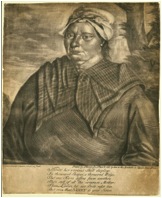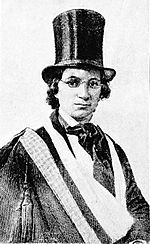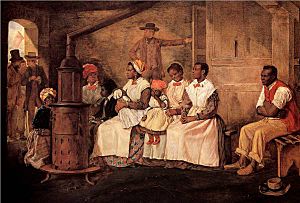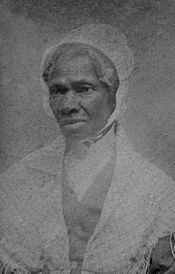Female slavery in the United States facts for kids
Slavery in North America began very early in the colonial history of the United States. It lasted until 1865. That's when the Thirteenth Amendment officially ended slavery everywhere in the United States. Slavery was also stopped among Native American tribes in Indian Territory after the war.
For a long time, there were more enslaved men than women. This meant their experiences were different. Enslaved African-American women and men lived and worked in many different places. They faced various challenges. As more African women were kidnapped and brought to the colonies, and more children were born into slavery, the numbers of enslaved men and women became more equal between 1730 and 1750. Enslaved African women faced both racism and sexism because they were both female and Black.
Contents
Slavery in Colonial America
Virginia's Enslaved Women
From 1700 to 1740, about 43,000 enslaved people were brought to Virginia. Most came directly from Africa. Studies suggest that the number of women and men brought in was about the same. Many children were also included. Most came from West Africa, and their cultures were very important in the lives of enslaved people in Virginia.
African values were strong. West African women's cultures, for example, showed deep bonds between mothers and children. They also showed strong connections among women in the community. The Igbo group from present-day Nigeria made up a large part of the enslaved population. Among the Igbo, female leaders (called omu) made decisions important to women and the whole community. Enslaved people came from many different cultural backgrounds. They came from places where women's communities were strong. But they were forced into a society that was unfair and treated them very harshly.
Girls in Virginia, especially Black girls, did not get an education. Most could not read or write. Enslaved African and African American women had many different jobs. The southern colonies were mostly farming areas. Enslaved women worked in the fields, planting and doing chores. They also worked a lot in homes. They nursed babies, took care of children, cooked, and did laundry.
Enslaved Women in New England

Historians describe New England as a "society with slaves." This means it had a small enslaved population. Its economy depended on sea trade and different kinds of farming. This was different from the Southern colonies, which were "slave societies." Southern societies relied heavily on enslaved labor. They had many enslaved people. Masters there had a lot of power over their slaves, often without legal limits.
New England had fewer enslaved people. Masters often saw themselves as protectors who should guide and care for their slaves. Enslaved women in New England had more chances to gain freedom. This was due to the legal system, owners sometimes freeing them, and chances for men to earn money. Men could sometimes earn enough to buy their wives' and children's freedom.
Enslaved women mostly did traditional "women's work." They were often hired out for daily tasks. They worked as maids, in kitchens, barns, and gardens. They did many household chores. This included polishing silver, helping with clothes and hair, drawing baths, and sweeping. They also emptied chamber pots, carried water, washed dishes, brewed drinks, and cared for children and the elderly. They cooked, baked, milked cows, fed chickens, spun, knitted, sewed, and did laundry. Their daily work was less physically demanding than field work in other regions. Still, enslaved women in New England worked very hard. They often lived in poor conditions and didn't get enough food. Because of hard work, poor housing, and bad diets, the average Black woman did not live past forty.
Sometimes, enslaved women were given as gifts to white women by their husbands. They were also given as wedding and Christmas presents. The idea that New England masters were kinder to their slaves than Southern owners is not true. Enslaved people had little freedom to move around. They also lacked access to education or training. Records show that enslaved people were sometimes branded or had their families separated. Many were sold secretly. This shows that the idea of "kindly masters" is a myth. Owners would treat their slaves harshly when they were angry.
Life in the Southern Colonies
No matter where they lived, enslaved people had very difficult lives. But labor in the Southern colonies was the hardest. The Southern colonies were "slave societies." Their economy and politics depended on enslaved labor. They had many enslaved people. Masters had huge power over them, often without legal limits. Plantations were the main economic power in the South. The work of enslaved men and women was their foundation.
Early on, enslaved people in the South worked mostly in agriculture. They grew indigo, rice, and tobacco on farms and plantations. Cotton became a major crop after the 1790s. Enslaved women did many different jobs. They were expected to work in the fields and also have children. This helped increase the enslaved population. Before the American Revolution, the enslaved female population grew mostly from births, not from new imports. Many enslaved women raised their children without much help from men.
Enslaved women were relied on to do house and field work. They also had to bear, feed, and raise children. Slaveholders wanted these children to keep their labor force growing. As house slaves, women were domestic servants. They cooked, sewed, acted as maids, and raised the planter's children. Later, they were also used in factories. They were important to the growth of the United States. They were kept at lower costs.
The Revolutionary War Era
During the American Revolutionary War (1775–83), enslaved women helped both sides. They served the Loyalist army and the Patriots. They worked as nurses, laundresses, and cooks. But as historian Carol Berkin writes, "African American loyalties were to their own future, not to Congress or to king." Enslaved women could be found in army camps. They worked building roads, making forts, and washing uniforms. However, they remained enslaved. Masters usually hired these women out to the military. Sometimes their children were hired out too.
Enslaved women also worked in shops, homes, fields, and plantations in every American colony. By 1770, there were over 47,000 enslaved Black people in the northern colonies. Almost 20,000 of them were in New York. More than 320,000 enslaved people worked in the Chesapeake colonies. They made up 37 percent of the population there. Over 187,000 of these enslaved people were in Virginia. In the Lower South, there were over 92,000 enslaved people. South Carolina alone had over 75,000. By 1770, planters there were importing 4,000 Africans each year. In many counties in the Lower South, the enslaved population was larger than the white population.
Serving in the military did not guarantee freedom for enslaved people. But Black men had a chance to escape slavery by joining the army. During the war, both men and women ran away. Men were more likely to escape. Pregnant women, mothers, and women caring for elderly family or friends rarely left those who depended on them. So many enslaved people left their plantations in South Carolina that there weren't enough workers to plant or harvest crops. As food became scarce, those who stayed suffered from hunger or enemy attacks.
The Crown gave freedom papers to over 914 women for helping Loyalist forces. But many women who gained freedom lost it again. This happened through unfair actions by others. Others who managed to stay free faced unfair treatment and poverty. When Loyalist plantations were captured, enslaved women were often taken and sold for the soldiers' profit. The Crown did keep promises to freed slaves. They evacuated them with troops at the end of the war. Over 3,000 Black Loyalists were resettled in Nova Scotia. Others went to the Caribbean and England. In 1792, Freetown in Sierra Leone was created as a colony for poor Black people from London and Black Loyalists from Canada.
One important voice for freedom during this time was Phillis Wheatley from Massachusetts. She was enslaved for most of her life but was later freed by her master. Wheatley was educated in Latin, Greek, and English. She wrote poems that said Africans deserved respect and freedom, just like Europeans.
In 1777, Vermont created a state constitution that banned slavery. In 1780, a judge in Massachusetts said slavery was against the state's new bill of rights. This bill stated that "all men...free and equal." Slavery effectively ended in Massachusetts with this ruling. This led to more enslaved men and women in New England suing for their freedom. Also in 1780, Pennsylvania passed a law to gradually end slavery. This law directly connected the ideas of the Revolution with the rights of African Americans to freedom.
In the South, the immediate result of the Revolution was that more slaveholders freed their slaves in the first two decades after the war. But the invention of the cotton gin made it possible to grow a lot more cotton. As new lands opened up for cotton and sugar, the demand for enslaved people grew. Lawmakers made it harder to gain freedom. They also passed stricter laws controlling the lives of African Americans.
The Antebellum Period (Before the Civil War)
As historian Deborah Gray White explains, "Black in a white society, slave in a free society, woman in a society ruled by men, female slaves had the least formal power and were perhaps the most vulnerable group of Americans."
The bond between mother and daughter was often the strongest and most valued among African-American families. Few women ran away. When they did, they sometimes escaped with their children. Historian Martha Saxton writes about enslaved mothers in St. Louis before the Civil War. She tells of a slave trader buying three small children from an owner. The children's mother killed them all rather than let them be taken away. She then died herself. Another story tells of a St. Louis trader taking a crying baby from its mother. Both were on their way to be sold. He gave the baby to a white woman nearby because its noise bothered him.
Songs about slavery and women's experiences were passed down through generations. African-American Women Work Songs are like historical pictures of their lives and survival. Songs speak of families being torn apart. They show the emotional pain enslaved women went through. Songs add to the tradition of oral storytelling. This helps pass down knowledge about history.
Young girls, some as young as seven, were often sold away from their mothers. For example, Mary Bell was hired out at age seven to care for three children. In 1854, Georgia was the first and only state to pass a law about selling mothers and children separately. Children under five could not be sold away from their mothers unless it was absolutely necessary.

Enslaved girls in North America often worked in homes. They provided household help. White families often looked for a "girl" to be an "all-purpose tool" in family life. The word "girl" was used for any working female without children. Enslaved girls were preferred because they cost less in the long run. These enslaved girls were usually very young, from nine years old to their mid-teens. Heavy household work was given to the "girl." This work became seen as "Black people's" work. A "girl" was a key helper for white families, both in the countryside and cities. She gave daughters freedom to focus on themselves. She also freed mothers from tiring work. She required no financial or emotional care.
Enslaved women in every state before the Civil War hoped for freedom. This hope was stronger in the North than in most of the South. Many enslaved people tried to gain freedom by buying themselves. They also used the legal system through freedom suits. Some ran away. This sometimes led to children and parents being separated. "Unfinished childhoods and harsh separations marked the lives of most African American girls. Mothers dreamed of freedom that would not bring more losses to their daughters."
The Antebellum South

After the Revolution, Southern plantation owners brought in many new enslaved people from Africa and the Caribbean. This continued until the United States banned the import of slaves in 1808. More than one million enslaved people were moved in a forced migration. This was part of the domestic slave trade. They were moved from the Upper South to the Deep South. Most were moved by slave traders. They traveled overland in chained groups called coffles, or by ships along the coast.
Most enslaved people in the Deep South, both men and women, worked on cotton plantations. Cotton was the main cash crop at this time. But enslaved people also worked on rice, corn, sugarcane, and tobacco plantations. They cleared new land, dug ditches, cut wood, and cared for livestock. They also repaired buildings and tools. Black women also cared for their children and did most of the housework. Enslaved women in the South faced both racism and sexism. Their roles in the family and community were very different from those of more traditional white American women.
Young girls generally started working earlier than boys. Many worked before age seven. Field work was usually seen as "men's work." But different estimates show that between 63-80 percent of women worked in the fields. The work of adult enslaved women depended a lot on the size of the plantation. On small farms, women and men did similar tasks. On larger plantations, men were given more physically demanding work. Few of the chores done by enslaved women took them off the plantation. So, they were less mobile than enslaved men. Men often helped their masters transport crops and supplies. They were also often hired out as skilled workers. Women also worked in homes as servants, cooks, seamstresses, and nurses. Even though a female slave's field labor was very important, the duties of having and caring for children greatly limited her life. This also helps explain why enslaved women were less likely to run away than men.
Freedom and the End of Slavery
Slavery was ended in the United States in 1865. This happened when the 13th Amendment was approved. In 1868, the 14th Amendment gave citizenship rights to African Americans.
Even though emancipation freed Black women from slavery, it also highlighted some unfairness between Black women and Black men. Black women were no longer servants to slave owners. But they became like contract servants to their husbands. This was due to the patriarchal principles that guided the role of women in marriage at the time.
Notable Enslaved Women
- Lucy Terry (c. 1730–1821) wrote the oldest known piece of literature by an African American.
- Phillis Wheatley (May 8, 1753 – December 5, 1784) was the first African-American poet. She was also the first African-American woman to publish a book.
- Sojourner Truth (c. 1797 – November 26, 1883) was born Isabella Baumfree. From 1843, she called herself Sojourner Truth. She was an African-American abolitionist and women's rights activist. Truth was born into slavery in Swartekill, Ulster County, New York. In 1826, she escaped to freedom with her infant daughter. She went to court to get her son back. She became the first Black woman to win such a case against a white man. Her most famous speech about gender unfairness, "Ain't I a Woman?", was given in 1851. This was at the Ohio Women's Rights Convention in Akron, Ohio. During the Civil War, Truth helped recruit Black soldiers for the Union Army. After the war, she tried to get land grants from the government for former slaves, but she was not successful.
- Harriet Jacobs (1813 or 1815 – March 7, 1897) wrote Incidents in the Life of a Slave Girl. This book is now seen as an "American classic."
- Harriet Tubman (born Araminta Harriet Ross; 1820 – March 10, 1913) was an African-American abolitionist and humanitarian. She was also a Union spy during the American Civil War. Born into slavery, Tubman escaped. She then made more than thirteen trips to rescue over 70 enslaved people. She guided them along the network of safe houses known as the Underground Railroad. She later helped John Brown recruit men for his raid on Harpers Ferry. After the war, she fought for women's right to vote.
- Ellen Craft (1826–1897) was an enslaved woman from Macon, Georgia. She pretended to be a white male planter to escape slavery. She escaped to the North in December 1848. She traveled openly by train and steamboat with her husband, who acted as her enslaved servant. They reached Philadelphia and freedom on Christmas Day.
|




